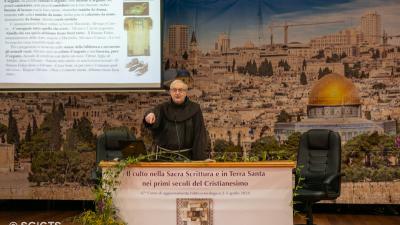
Saint Savior's Monastery knows no slumber. In the basement, work continues on the development of the historical wing of the future Terra Sancta Museum. It will certify and highlight the mission of the Custody of the Holy Land and its relations with European countries, especially through the exhibition of works that have been conserved by the Custody for centuries. These liturgical and artistic objects are managed by the Bureau of Cultural Property, established in 2010, which is headed by Br. Stéphane Milovitch.
This office was opened alongside the Inventory of the Saint Savior's Monastery, and it was begun by the same friar with the help of Italian volunteers, Alfonso Bussolin Irene Boschetti. The latter said, “It's been a long time since inventories were made in the monastery. By coincidence, perhaps because the time had come, Alfonso began to take pictures of objects and list them. And that was it. We spent hours and hours in the nooks and crannies of several monasteries. I remember those months when we were locked in the room making inventories of objects behind Saint Savior's sacristy. We would work on the mezzanine in the morning, we we would go downstairs, and we would measure; Alfonso would take photos and we would put the information into the computer before putting the objects away again.” They made inventories at St. Catherine's Monastery in Bethlehem, at St. John's in Ain Karem, at St. Savior's in Jerusalem and at the Holy Sepulcher. This allowed them to retrieve forgotten ornaments, treasures lost in the dust and in the abandoned rooms of the monastery. Irene recalled, “In the basement of the former sewing room, we found a piece fabric cut strangely, without any writing on it. It was when we were looking at these old photographs in hopes of finding out more about it that Br. Stéphane realized that the fabric was part of the former siding materials at Saint Helen's grotto at the Holy Sepulcher!”
This very detailed work has been completed with the help of students, teachers and art history specialists. The latter have been putting their expertise at the service of the Custody for periods of varying length and they help to deepen the Custody's knowledge of its own heritage. The inventory has led to the creation of a database for all of the available information on each object. It is updated whenever an object changes place anytime it is studied in depth by an expert.
“This heritage does not belong to us,” said his manager. “It was gifted to the holy places and we are here to preserve and highlight the name of the Catholic Church. When the friars had economic problems during the wars for example, they never got rid of these objects.” They are artistic and liturgical objects given as a gift for worship and it is crucial for the Franciscans that they remain sacred. They should not only be admired for their beauty in a museum. We use them during liturgies so that this beauty may elevate us to the Supreme Beauty, who is God.” Since the inventory was finished, everything has been in order and Irene had made it a point that it remain that way. The ornaments are sometimes used during solemn celebrations. So, for the vespers following the ordination in June 2015, young Franciscan priests prayed with the chasubles offered by the Custody by the French King Louis XIII to the Holy Sepulcher.
The beauty and variety of the goods offered to the Holy Places reveal the people's faith. Among the countless anecdotes, Irene recalled, “One day, a pontifical ceremony expert came to visit us after seeing the liturgical ornaments gifted over the centuries by various European courts, he admired them and remarked: “In Rome, we have precious ornaments, but they are not as beautiful. They were manufactured for the popes, but here they here these were made for Christ!” The craftsmen excelled in their trade and monarchs did not skimp because they knew that their works were destined for the Holy Sepulcher or the holy places.”




